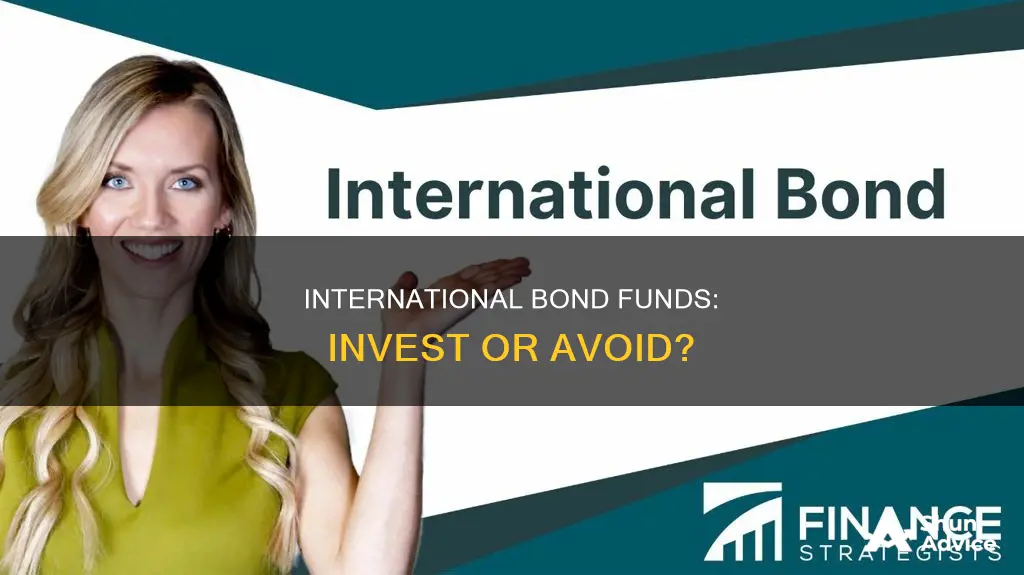
Investing in international bond funds can be a great way to diversify your portfolio and reduce risk. While investing in foreign bonds can be risky due to currency fluctuations and other economic factors, it can also provide exposure to other parts of the world, potentially offsetting losses in domestic bonds. International bonds can add stability to your portfolio as markets outside the United States don't always rise and fall simultaneously with the domestic market. Additionally, the global bond market is far larger and more liquid than the global stock market, providing a stable investment option. However, it's important to carefully consider the risks and potential returns before deciding whether to invest in international bond funds.
| Characteristics | Values |
|---|---|
| Purpose | Portfolio diversification |
| Advantage | Exposure to other parts of the world |
| Advantage | Level out volatility in your portfolio |
| Advantage | Spread out your portfolio's risk |
| Advantage | Protection against capital drawdowns |
| Disadvantage | Higher and unique risks |
| Disadvantage | Increase portfolio volatility |
| Recommendation | Aggressive investors could consider an allocation to unhedged foreign bonds of 20% of their allocation to bonds |
What You'll Learn

Foreign bonds can be volatile
However, adding foreign bonds to a portfolio can also increase volatility. This is because investing in a foreign bond is also an investment in a foreign currency, and currency investments can be volatile. Exchange rates fluctuate, and so the bond's dollar value and investment return can fluctuate, even if the bond's price remains the same. For example, if an investor buys 1,000 euros of French bonds when the euro is worth $1.19, they pay $1,190 for the bonds. If the euro weakens against the dollar to $1.10, then those French bonds are now worth $1,100.
Foreign bonds denominated in the issuing country's currency will have an inverse correlation with the dollar. So, if the issuing country's currency rises relative to the dollar, the bond will benefit. However, if the dollar rises relative to the issuing country's currency, the bond will be at a disadvantage.
There are ways to mitigate the volatility of foreign bonds. One solution is to hedge the currency risk. However, this lowers the diversification benefit. Foreign bonds can also be purchased through mutual funds and ETFs, which will be more diversified than a single bond.
Launching an Investment Fund: Training for Beginners
You may want to see also

International bond funds can add stability
Foreign bonds can protect capital against drawdowns or outsized drawdowns, and they give investors exposure to other parts of the world. For example, if you have bonds in European and Asian countries that are performing well, while the US economy is declining, your bonds will do well, even if your US bonds are not. In this case, being diversified outside of the US limits the negative impact of your bond holdings from a US decline.
Markets outside the US do not always rise and fall at the same time as the domestic market, so owning both international and domestic securities can level out some of the volatility in your portfolio. This can spread out your portfolio's risk more than if you owned just domestic securities.
Research shows the factors driving foreign bond returns are usually not highly correlated to the same US factors. For example, a recent 20-year correlation between US and foreign bonds that are not currency-hedged has been about .5 on a scale of -1 to +1. Here, +1 means that the assets always zig and zag together and -1 means that they always move in opposite directions. Thus, .5 signifies reasonable diversification. For currency-hedged bonds, the correlation is .9, meaning little diversification.
However, it is important to note that adding foreign bonds to a portfolio can also increase volatility. This is because an investment in a foreign bond is also an investment in a foreign currency, and currency investments can be volatile.
A Guide to Investing in Canadian Mutual Funds
You may want to see also

Diversification is a key benefit
Firstly, investing in international bond funds allows investors to access hundreds or even thousands of foreign securities. This broad range of international holdings can add stability to a domestic portfolio and reduce overall risk.
Secondly, markets outside the United States do not always rise and fall simultaneously with the domestic market. Therefore, owning both international and domestic securities can help level out some of the volatility in an investment portfolio. For instance, if you have bonds in European and Asian countries that are performing well while the US economy is declining, your bonds will likely still perform well.
Thirdly, international diversification can help spread out the portfolio's risk more effectively than owning just domestic securities. Vanguard, for example, recommends that investors allocate at least 20% of their overall portfolio to international stocks and bonds. However, to achieve optimal diversification, they suggest allocating around 40% of the stock allocation to international stocks and about 30% of the bond allocation to international bonds.
Finally, research shows that the factors driving foreign bond returns are usually not highly correlated with the same factors in the US. For instance, a recent 20-year correlation study between US and foreign bonds that are not currency-hedged showed a correlation of 0.5 on a scale of -1 to +1, indicating reasonable diversification.
However, it is important to note that adding foreign bonds to a portfolio can also increase volatility, especially due to the impact of currency exchange rates. Therefore, investors should carefully consider the potential benefits of diversification against the risks involved in international investments.
Choosing a Fund: Key Factors for Smart Investing
You may want to see also

Currency fluctuations can affect returns
Currency fluctuations can significantly impact returns on international bond funds. When an investor buys a foreign bond, they are also investing in a foreign currency. This means that the value of their investment can be affected by changes in exchange rates. For example, if an investor buys 1,000 euros of French bonds when the euro is worth $1.19, they pay $1,190 for the bonds. However, if the euro weakens against the dollar to $1.10, the value of their investment decreases to $1,100.
The direction of currency movements can have both positive and negative effects on the performance of international bond funds. If the currency of the issuing country appreciates relative to the dollar, the investor's bond will benefit. Conversely, if the dollar strengthens against the issuing country's currency, the bond will be at a disadvantage.
To mitigate the impact of currency fluctuations, investors can consider hedging their currency risk. However, as pointed out by Robert Stepleman, this can reduce the diversification benefit of adding international bonds to a portfolio. Another way to manage currency risk is to invest in international bonds that are hedged in U.S. dollars. By doing so, investors can dampen the volatility associated with currency fluctuations while still gaining exposure to foreign bond markets.
Overall, while currency movements can affect the returns on international bond funds, they are just one of several factors that influence the performance of these investments. Other factors include the direction of interest rates, inflation expectations, the credit of the issuer, and the monetary and fiscal policies of the issuing country.
Setting Up an Investment Fund in Ireland: Where to Start?
You may want to see also

Foreign bonds carry unique risks
For example, if an investor buys 1,000 euros of French bonds when the euro is worth $1.19, they pay $1,190 for the bonds. If the euro weakens against the dollar to $1.10, those French bonds are now worth $1,100. This currency risk can be hedged, but that lowers the diversification benefit.
Bonds from developed countries such as the UK, France, and Germany are generally safer than bonds from emerging markets such as Indonesia, Malaysia, and Kenya. Bonds from developing countries should only make up a smaller portion of foreign bond holdings.
There are other factors that affect foreign bond prices, including the direction of interest rates, inflation expectations, credit of the issuer, and the monetary and fiscal policies of the issuing country.
Large US Companies: Halal Index Fund Investing?
You may want to see also
Frequently asked questions
International bond funds can add stability to a domestic portfolio and provide diversification. Markets outside the US don't always rise and fall at the same time as the domestic market, so owning both international and domestic securities can level out some of the volatility in your portfolio.
International bonds can increase the volatility of your portfolio. This is because an investment in a foreign bond is also an investment in a foreign currency, and currency investments can be volatile.
Investors who are not comfortable with the volatility of international bond funds may prefer to invest in bonds over bond funds. Bonds are typically held by the investor until maturity, and there is no loss of principal as long as the investor holds the bond until maturity.
To dampen the volatility of international bond funds, consider international investments hedged in US dollars. You can also invest in foreign bonds through mutual funds and ETFs, which will be more diversified than a single bond.
Vanguard recommends that at least 20% of your overall portfolio should be invested in international stocks and bonds. To get the full diversification benefits, consider investing about 40% of your stock allocation in international stocks and about 30% of your bond allocation in international bonds.







